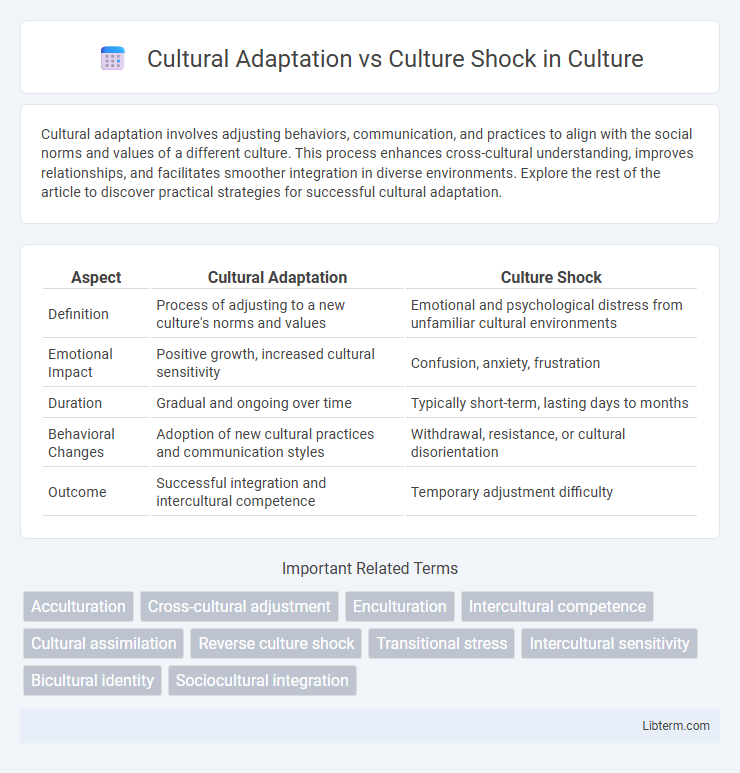Cultural adaptation involves adjusting behaviors, communication, and practices to align with the social norms and values of a different culture. This process enhances cross-cultural understanding, improves relationships, and facilitates smoother integration in diverse environments. Explore the rest of the article to discover practical strategies for successful cultural adaptation.
Table of Comparison
| Aspect | Cultural Adaptation | Culture Shock |
|---|---|---|
| Definition | Process of adjusting to a new culture's norms and values | Emotional and psychological distress from unfamiliar cultural environments |
| Emotional Impact | Positive growth, increased cultural sensitivity | Confusion, anxiety, frustration |
| Duration | Gradual and ongoing over time | Typically short-term, lasting days to months |
| Behavioral Changes | Adoption of new cultural practices and communication styles | Withdrawal, resistance, or cultural disorientation |
| Outcome | Successful integration and intercultural competence | Temporary adjustment difficulty |
Understanding Cultural Adaptation
Cultural adaptation involves gradually adjusting to new cultural environments by learning local customs, norms, and values, which facilitates smoother social interactions and integration. It requires flexibility and open-mindedness to effectively navigate differences in communication styles, social behaviors, and expectations. Understanding cultural adaptation is crucial for minimizing misunderstandings and enhancing personal and professional relationships in diverse settings.
Defining Culture Shock
Culture shock is a psychological experience of disorientation and stress that occurs when individuals encounter an unfamiliar cultural environment. It manifests through feelings of confusion, anxiety, and frustration as people struggle to adjust to new social norms, language barriers, and daily routines. Understanding culture shock is crucial for effective cultural adaptation, which involves actively learning and integrating into the host culture to regain emotional balance and functionality.
Stages of Cultural Adaptation
Cultural adaptation involves progressive stages including the honeymoon phase, characterized by excitement and fascination with the new culture, followed by the frustration phase, where cultural differences and language barriers create stress and confusion. This is succeeded by the adjustment stage, where individuals gradually develop coping mechanisms and cultural competence, leading to eventual acceptance and integration. Culture shock, often experienced during the frustration stage, highlights the emotional and psychological challenges encountered before successful cultural adaptation occurs.
Phases of Culture Shock
Culture shock typically unfolds in four distinct phases: honeymoon, frustration, adjustment, and acceptance. During the honeymoon phase, individuals experience excitement and fascination with the new culture, while the frustration phase involves feelings of anxiety and confusion as cultural differences become challenging. The adjustment phase marks increased understanding and coping strategies, leading to the acceptance phase where individuals achieve comfort and effective functioning within the new cultural environment.
Key Differences: Adaptation vs. Shock
Cultural adaptation involves gradual adjustment and learning to function effectively within a new cultural environment, promoting positive growth and integration. Culture shock refers to the initial disorientation and stress experienced when encountering unfamiliar cultural norms, often characterized by confusion, frustration, or homesickness. The key difference lies in adaptation being a proactive, long-term process of embracing change, while culture shock represents a temporary, reactive response to cultural discrepancies.
Psychological Impact of Cultural Transitions
Cultural adaptation involves a gradual psychological adjustment to new social norms and values, fostering resilience and cognitive flexibility. In contrast, culture shock triggers intense emotional distress, including anxiety, confusion, and homesickness, as individuals face unfamiliar cultural environments. Effective coping strategies and social support systems are crucial in mitigating the psychological impact of these cultural transitions, promoting mental well-being and successful integration.
Coping Strategies for Culture Shock
Effective coping strategies for culture shock include developing cultural awareness through language learning and engaging with local customs to reduce feelings of alienation. Building a social support network with both locals and fellow expatriates fosters emotional resilience and provides practical guidance. Maintaining a positive mindset and practicing self-care techniques such as mindfulness or regular exercise helps manage stress during the adjustment period.
Benefits of Successful Cultural Adaptation
Successful cultural adaptation enhances cross-cultural communication skills, fostering empathy and reducing misunderstandings in diverse environments. It promotes personal growth by increasing flexibility and open-mindedness, allowing individuals to effectively navigate new social norms and workplace dynamics. Improved cultural adaptation also boosts career opportunities and global collaboration, benefiting both individuals and organizations in multicultural settings.
Common Challenges in Adapting to New Cultures
Common challenges in adapting to new cultures include language barriers, which hinder effective communication and social integration. Navigating different social norms and values can cause misunderstandings and discomfort, often leading to feelings of isolation or frustration. Emotional stress from homesickness and uncertainty further complicates the cultural adaptation process, impacting mental well-being and daily functioning.
Tips for Navigating Cultural Differences
Navigating cultural differences requires embracing open-mindedness and active listening to understand diverse social norms and values. Developing cultural awareness through research and respectful curiosity helps minimize misunderstandings and fosters meaningful connections. Practicing patience and flexibility enables smoother transitions and reduces the impact of culture shock during cultural adaptation.
Cultural Adaptation Infographic

 libterm.com
libterm.com